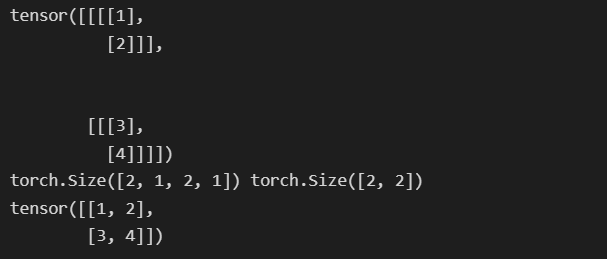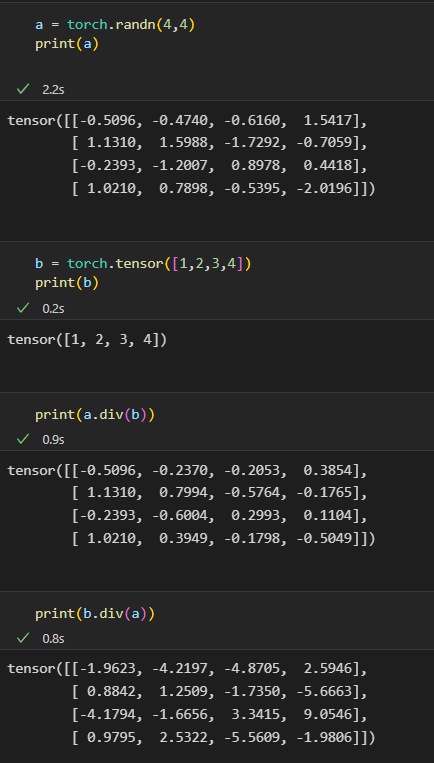-
PIL+pyplot+transforms.ToTensor+unsqueeze+div
PIL & pyplot
from PIL import Image import matplotlib.pyplot as plt from torchvision import transforms # PIL打开图片 img_PIL = Image.open("data/style/cat.jpg") print(img_PIL) print(type(img_PIL)) # img_PIL.show() # 调用os system自带的browser来显示图片 # plt.imshow(img_PIL) # plt.show() # plt打开图片 img_plt = plt.imread("data/style/cat.jpg") print(img_plt.shape) print(type(img_plt)) # plt.imshow(img_plt) # plt.show()- 1
- 2
- 3
- 4
- 5
- 6
- 7
- 8
- 9
- 10
- 11
- 12
- 13
- 14
- 15
- 16
- 17
- 18

可以看到plt打开的图片格式为HxWxC且数据类型为numpy.ndarray,并不是张量形式,所以 plt 打开的图片也要用transforms.ToTensor来转化为张量。因为PIL打开的图片并不是张量的形式,所以需要
transforms.ToTensor()来转换为张量transforms.ToTensor
convert a
PIL Imageornumpy.ndarrayto tensor
Converts a PIL Image or numpy.ndarray (H x W x C) in the range [0, 255] to a torch.FloatTensor of shape (C x H x W) in the range [0.0, 1.0]# PIL打开图片 img_PIL = Image.open("data/style/cat.jpg") img_PIL = transforms.ToTensor()(img_PIL) print(img_PIL.shape) # output:torch.Size([3, 940, 940]) # plt打开图片 img_plt = plt.imread("data/style/cat.jpg") img_plt = transforms.ToTensor()(img_plt) print(img_plt.shape) # torch.Size([3, 940, 940]) print(type(img_plt)) #- 1
- 2
- 3
- 4
- 5
- 6
- 7
- 8
- 9
- 10
- 11
输出为 ( C × H × W ) (C \times H\times W) (C×H×W)
或者用
transforms.Compose打包transforms.ToTensor()transform = transforms.Compose([transforms.ToTensor()]) # PIL打开图片 img_PIL = Image.open("data/style/cat.jpg") img_PIL = transform(img_PIL) print(img_PIL.shape) # output:torch.Size([3, 940, 940])- 1
- 2
- 3
- 4
- 5
- 6
- 7
torch.unsqueeze(input,dim,out=None)
在指定位置添加维度
# plt打开图片 img_plt = plt.imread("data/style/cat.jpg") img_plt = transform(img_plt) print(img_plt.shape) print(type(img_plt)) # 在指定的维度上插入1维 img_plt = img_plt.unsqueeze(2) print(img_plt.shape) print(type(img_plt))- 1
- 2
- 3
- 4
- 5
- 6
- 7
- 8
- 9
- 10

通常的使用方法是img = transform(img).unsqueeze(0)transform = transforms.Compose([transforms.ToTensor()]) # plt打开图片 img_plt = plt.imread("data/style/cat.jpg") print(img_PIL.shape) print(type(img_PIL)) # img_plt = transforms.ToTensor()(img_plt) img_plt = transform(img_plt) img_plt = img_plt.unsqueeze(0) print(img_plt.shape) print(type(img_plt))- 1
- 2
- 3
- 4
- 5
- 6
- 7
- 8
- 9
- 10
- 11
- 12

unsqueeze(0)就是在最外层增加了一个维度。unqueeze()这个函数主要是对数据维度进行扩充, 起到升维的作用,方便后续图像处理可以更好地批处理。这是应该是因为网络的接收输入是一个mini-batch,image unsqueeze后第一个维度是留给batch_size的torch.squeeze(input, dim=None, out=None)
去除那些维度大小为1的维度
不传入dim时,则删除所有大小为1的维度
import torch b = torch.tensor([[[[1],[2]]],[[[3],[4]]]]) print(b) print(b.size(),b.squeeze().size()) print(b.squeeze())- 1
- 2
- 3
- 4
- 5

传入dim时,仅在给定尺寸中进行挤压操作
x = torch.zeros(2, 1, 2, 1, 2) # dim0的维度为2,所以挤压后不变, # squeeze(0)表示如果dim0的维度为1则删除dim0 print(x.size(),x.squeeze(0).size()) print(x.size(),x.squeeze(1).size(),x.squeeze(1).size()) # 不影响x的原来的形状 print(x.shape)- 1
- 2
- 3
- 4
- 5
- 6
- 7
- 8
- 9
- 10
torch.div
张量和标量做逐元素除法
或者两个可广播的张量之间做逐元素除法

-
相关阅读:
Ubuntu 22.04 | 20.04 |18.04 上安装 PHP 8.1
Vue2 Element DatePicker组件设置默认日期、控制日期范围
leetcode 136. 只出现一次的数字
【Java+SpringBoot】小区物业管理系统(源码+代码讲解+答辩教学+毕设选题)
PIC10F200单片机编程总结-0
three.js学习笔记
心脑体漫画版本
学习记忆——数学篇——算术——无理数
300万赛事门票上链,杭州亚运会打造史上首个“链上亚运”
C++基础语法
- 原文地址:https://blog.csdn.net/weixin_43845922/article/details/128148209

